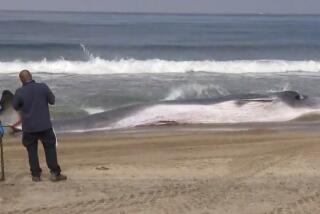Rocky’s Legacy: Increasing Knowledge of Rare Whale : Animals: The stranding and death of the minke are providing scientists a once-in-a-lifetime chance to study the mammal and effects of ocean pollution.
Dead or alive, Rocky the whale was wanted.
For the beach-goers who found the ailing minke whale pup flopping on a rock jetty in Newport Beach a week ago Saturday, it was a once-in-a-lifetime opportunity to get close to a mysterious ocean mammal that has fascinated mankind at least since the Old Testament tale of Jonah.
But for a network of scientists and dedicated whale-watchers across Southern California, it was a rare chance to study the behavior and body of a little-known species.
“All these strandings are like the pieces of a puzzle, when you’re looking at the biology of a species,” said John Heyning, curator of mammals at the Los Angeles County Museum of Natural History. “Eventually, if you get enough pieces, you get a good idea of how these animals live in the wild.”
Through a volunteer network coordinated by the federal government, Heyning is responsible for all marine mammal strandings on Orange County beaches. He and his staff operate a hot line for strandings discovered in Los Angeles and Orange counties, taking calls directly during the week and calling in for messages every couple of hours on weekends and holidays.
On July 24, they were on the scene an hour after Rocky--so named by his rescuers--was discovered by an early morning jogger.
By late afternoon, Rocky was in a holding tank, antibiotics and anti-inflammatory drugs pumped into his stomach, with veterinarians and attendants scheduled to work around the clock to help keep him alive. He died the next morning of a weeks-old infection, but as the first minke to strand himself in California in scientists’ memory, Rocky remains somewhat of a celebrity.
“Most of the time when we see them, they’re dead, they’ve been dead for a while and they’re starting to decompose,” said Dennis Kelly of Corona del Mar, an Orange Coast College professor who specializes in marine mammals.
“To have one come up freshly dead is even more rare and to have one come up alive is unheard of. To have time to get it off the beach alive is absolutely unheard of,” he said. “It’s a gold mine for scientists.”
Ten scientists from half a dozen institutions crowded around a table at Sea World last week to dissect Rocky, studying his reproductive system, blood consistency, eating habits and organs. Extensive tissue samples from the whale’s body are being analyzed at the natural history museum in Los Angeles, which houses an extensive collection of whale remains.
Eventually, a reproduction of Rocky’s head will be part of an exhibit at the Los Angeles museum.
Rocky already has taught experts that inserting a tube into a minke whale’s stomach is an acceptable medical procedure, said Sea World veterinarian Thomas Reidarson. That was what was done to get water into Rocky when the dehydrated animal arrived at Sea World.
More lessons will come with the results of toxicology studies and the analysis of bacteria cultures from the whale’s body, and when tests reveal the source of the infection that killed him. Environmentalists see whales as crucial barometers of the impact of pollutants on the ocean.
“(Strandings are) something that no one is looking forward to because we know that when they get to this point, they’re so debilitated they’re probably not going to make it,” Reidarson said. “But it’s exciting because we don’t get an opportunity to (examine beached whales) very often. It’s incredible for us.”
Whales typically come ashore only when they are desperately ill, so disoriented that they lose their way or so weak that they cannot handle the rough ocean.
About 2,000 marine mammals wash ashore in California each year, 99% of them seals and sea lions. Forty percent of the seals and sea lions survive, but almost none of the whales do.
On the rare occasions when stranded whales are breathing, there is often virtually no life left by the time the medical and scientific experts arrive.
For members of the stranding network, every sighting of a whale on a beach is an emergency. Baleen, or toothless, whales such as the minke are especially exciting to find because they are not kept in aquatic parks and therefore are less studied than killer whales.
The smallest of the baleen whales, minkes are among the most mysterious, even though there are thought to be about 900,000 of them roaming the world’s waters.
Known as “slinky minke” for their habit of darting in and out of the view of boaters, and “stinky minke” for their notorious bad breath, minkes reach about 25 feet at maturity.
Unlike many whales, minkes are solitary animals. They do not show their tails when diving or have visible blowholes, making them all the more elusive.
“It’s an animal you just don’t see that much,” said Alisa Schulman Janiger, a San Pedro marine biology teacher active in the American Cetacean Society, one of the oldest associations of whale lovers in the country. Janiger coordinates a daily whale watch atop the Palos Verdes Peninsula from December to May. “They’re difficult to spot, difficult to track, and therefore difficult to study,” she said.
Violating a 1987 ban by the International Whaling Commission, Norwegians began to hunt minke whales commercially this year. The Japanese also hunt minkes, although only for research purposes.
Whale hunting and ocean pollution have led thousands of environmentalists to rally around the great mammals, and strandings--particularly of whales--always make headlines. News of Rocky’s stranding, including videotaped images of him fighting for his life on the jetty, was broadcast internationally on Cable News Network.
More to Read
Sign up for Essential California
The most important California stories and recommendations in your inbox every morning.
You may occasionally receive promotional content from the Los Angeles Times.









